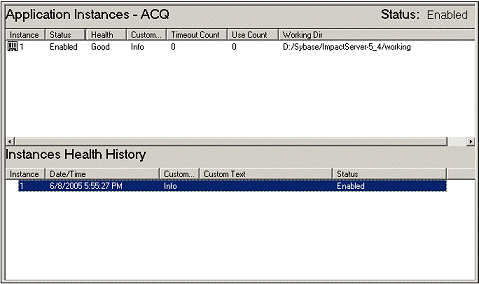

The Instances view (Figure 3-3) displays the number of instances of the application currently enabled. An application can be configured to run more than one instance. Each instance is an independent copy of the application.
Figure 3-3: ODL AIM application Instances view

Beneath Instances Health History, application instances can display a Custom Status and Custom Text, which allow the AIM developer to raise errors or warnings inside the ODL code.
Custom Status values are:
Info – corresponds to “Good”
Warning – corresponds to “Problematic”
Error – corresponds to “Bad”
ODL publishing allows developers to change an object’s health according to the conditions shown. For example, when the endpoint application fails.
To publish an AIM’s status and text from ODL, call this function:
clSetAimStatus(int code,
string *text);
where code displays in the Instance Health Summary section of the right pane as Health Code:
INFO (good)
WARNING (problematic)
ERROR (bad).
and text is user-defined content that appears in the Custom Health Text column of the Instance Health Summary section in the bottom pane of the General view.
![]() For more information about clSetAimStatus(),
refer to the e-Biz Impact ODL Guide.
For more information about clSetAimStatus(),
refer to the e-Biz Impact ODL Guide.
By default, an endpoint failure does not change the status of the e-Biz Impact destination to which is sending. From an e-Biz Impact point of view, the destination is still alive and is capable of accepting transactions from the SFM, so to the console, the destination appears healthy. ODL publishing allows the user to set the destination's health to “bad” if this condition occurs.
ODL supports publishing an AIM’s status with text to the Global Console. This information shows up in the Global Console as Custom Health Code and Custom Health Text.
Custom Health Text is a user-defined message written in ODL and raised by an application.
| Copyright © 2005. Sybase Inc. All rights reserved. |

|
|